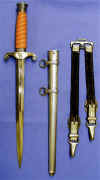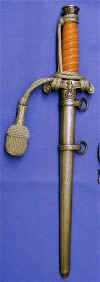|
|||||||
|
Organisational Information - The German Army [Heer] After World War I the German army was restricted to 100,000 officers and men by the victorious armies of WWI, deemed sufficient for home defence but not large enough for German expansion into other nation's domains. Hitler, on his rise to power, quickly saw an ally in the German Army as they wished to become the force they were before World war I. Hitler started to expand the German Army when he felt confident that the rest of Europe would not oppose his actions in defiance of WWI treaties. During World War II, Hitler took full control of the German Army as its victories turned to defeats, personally commanding many divisions over his chosen Generals. He never really trusted the Generals after this date, and made blunders by being to removed from the front line.
Thus, an outstanding characteristic of German military operations in World War II was a remarkable co-ordination of the three sister services composing the German Wehrmacht: The Army, Air Force and Navy. The value of a balanced combined arms force was vividly demonstrated by the early German campaigns, when aircraft, tanks, and infantry were successful ingredients of the Blitzkrieg. At the heart of this powerful Wehrmacht was the German Army. In mobilising for WWII, the growth of the Army was spectacular, and the result was one of the finest military machines known to history. German WWII Army Statistics
|
||||||||||||||||||||||||||||||||
Dagger Information - Army (Heer) The army dagger was designed by Paul Casburg and was allowed as a side arm option in place of the Army sword in 1935. The grip came in white, yellow or orange and had a carved groove format, running clockwise, on the grip. Grips could also be acquired in solid ivory as well as other materials at extra cost. One type is the Amber glass grip that is twice as heavy as real amber. Early grips are found being a solid plastic material, by 1939 the grips changed to being plaster filled and wood base with a plastic coating. The very early cross guard and pommel were made from brass with a thick 4 microns of silver plating. Later issued fittings range from nickel based to an alloy plated with 1-2 microns of silver, as well as nickel plating. The last daggers made had a dull gray oxide finish. It should be noted that early daggers were finished with a dark burnishing in the reassess of the fittings, that was to make the dagger look like an antique. Cast onto the cross guard was an eagle with wings wide open holding an oak leaf wreath in its talons. At the centre of the wreath was a swastika. The pommel had a ring of oak leaves rising vertically from the grip to the pommel top, with the pommel screwed onto the blade tang to secure the grip, cross guard and blade. On early daggers there was a clear lacquer applied over the fittings. The blade was 25.5 to 26.5 cm long and had no motto or engraving as standard. Many blades were cross-grained polished, a few makers used a nickel plating that is highly prized today by modern collectors. Etching as well etched presentations, or applied presentation Damascus or just plain damast blades were available at extra cost. Its rare to find real damast blades with a trademark on them as this cost the buyer extra to have this applied. Early Army dagger’s had a brass based scabbard, that after 1936 went to a steel based scabbard that was covered in a simple "pebble dash" finish. Again the very early brass based had 4 microns of silver plating where as the later were reduced to 1-2 microns of silver finish as well as the nickel finish and late issues with the gray oxide finish. Pressure fitted to the scabbard were two hanger suspension rings with oak leaf patterns onto which the hanger was clipped. The early daggers had a clear lacquer applied over the finish. Two hanger straps, Silver coloured face with field grey velvet backs were used. The fittings range from base material of silver-plated brass to a natural aluminium finish. The fittings are as follows; oval buckles with oak leaf patterns with matching slides and clips and an upper open clip loop were used to suspend the dress dagger from the officer’s belt or in pocket hanger. The fittings on some hanger’s can be found with a gold finish that is perhaps for the rank of General. A Silver 42-43 cm Portapee was tied around the dagger grip to complete the dagger accoutrements. Again these portepee’s can be found in many materials as well as a gold Portapee, but is very rare. The insert is plain and not twisted in a circle like the Navy style of Portapee. The Army dagger ceased production in May 1943 possibly earlier. Just as a side note on Army daggers, variations can be found with Gold finished hilt fittings and scabbard, this extra cost item would have been for perhaps a General. This is a very rare variation and is seldom encountered. The gold finish has a dull gold look. Edited by Bruce Petrin |





